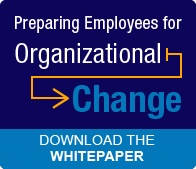How can you prepare your employees for organizational change? Is there a change management training option that delivers the skills and knowledge employees need to succeed in the face of overwhelming change? Over the past two weeks, we talked about the first two challenges employees face while going through a personal transition during an organizational change: 
- Remain Productive - “Are Your Employees Ready to Join the Change Dance?”
- Be Professional - “Hands Up! Are Your Employees Ready for the Organizational Change Roller Coaster Ride? “
There is one more challenge faced by individuals during a transition:
- Be Proactive – Giving employees the skills to self-manage through the change
The key to helping employees be proactive during a personal transition is to provide them with change-ready tactics they can deploy. Examples of tools to provide include:
-
A set of coping strategies
-
An understanding of common losses and endings
-
An Action Plan for self-managing through the transition.
Let’s take a closer look at each tactic.
Coping Strategies
When faced with a personal transition, individuals will typically choose one of these 5 coping strategies:
- Flight – This is an active withdrawal from the change. The individual does not acknowledge the change going on around her, and shifts her focus elsewhere.
- Freeze – Individuals choose to freeze, and are both unable and unwilling to change. They entrench themselves in the status quo.
- Fight – “Not Gonna Happen”. That’s the slogan of an employee who decides to fight the change. He doesn’t agree with the change, becomes angry, complains a lot, and blames others.
- Fake It – These individuals will say they are “ok” with the change, but the reality is that they won’t change their actual behavior. They will attempt to meet the new challenges with their old behaviors.
- Face Up to the Loss – People who face up to the loss are willing to leave their own comfort zone. They tend to be problem-solvers, and seek out challenges. They will find the silver lining in the change.
Once employees identify their “go-to” strategy, they need to ask themselves whether the strategy is actually working. Or not!
Common Losses and Endings
The reluctance to change is due not only to the content of the change, but to the endings and losses that go with it. Common losses and endings that can occur during a change include:
- Possible changes to current job design or future job opportunities
- Personal work relationships/connections
- Freedom from unknown risk, fear, and apprehension
- Confidence in predicting organizational behavior, tactics, and reactions
- Ability to exercise direction or restraint over work-related events
Once these endings are identified and accepted individuals are able to more easily navigate through a transition.
Action Plan
When individuals believe that they can take action, they unquestionably feel more in control. And when employees feel more in control, there is less resistance to change. In fact, giving employees a sense of involvement and control are key enablers to having a productive workforce in the face of overwhelming change.
IMA’s ChangePro Workshop is change management training for employees that helps them productively self-manage through the roller coaster of change. Are you doing all you can to prepare them for the ride?


